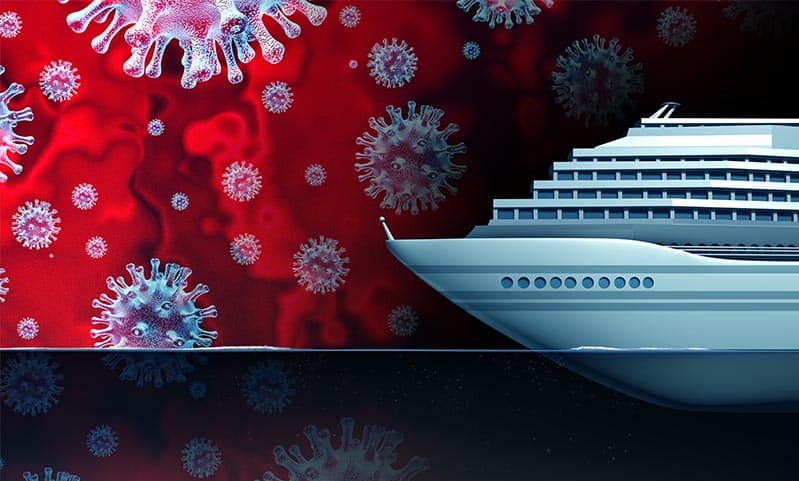Princess Cruise Lines knew that several people aboard the Grand Princess were infected with the coronavirus COVID-19, yet the ship set sail for Hawaii anyway, according to court documents.
An earlier coronavirus outbreak on the Diamond Princess put the company on notice that there was a problem, the plaintiffs allege.
Therefore, when individuals on the Grand Princess got sick, the company had a duty to protect passengers and people.
Yet the company did nothing.
“It would only stand to reason, that having experienced such a traumatic outbreak on board one of its vessels less than a month prior to the current voyage on board the Grand Princess, that the defendant would have learned to take all necessary precautions to keep its passengers, crew and the general public safe,” they remarked.
The Grand Princess was quarantined in California for several weeks, meaning that passengers were confined to their cabins. Despite the quarantine, twenty-one passengers and crew have confirmed coronavirus cases.
Cruise Ship Injuries: An Overview
Infectious diseases are a serious concern aboard tightly-packed cruise ships.
Generally, cruise ship owners have a legal duty to protect passengers and crew against foreseeable outbreaks.
“Foreseeable” does not mean inevitable or even likely. Instead, foreseeable usually means “within the realm of possibility.” This duty includes things like:
- Screening passengers and crew for known infectious diseases, like coronavirus, flu, or measles,
- Frequently sanitizing surfaces, especially in common areas,
- Providing reasonable accommodations for quarantined individuals, and
- Taking prompt action to limit the spread of an infectious disease.
These same general principles apply to things like swimming pool injuries, falls, assaults, and other premises liability injuries.
Cruise ship lines have a duty to provide safe environments for their passengers.
This duty includes regular inspections that ensure safety.
Cruise ship injuries are the same types of wounds which people experience on land. But in many cases, the laws are different.
For example, when workers on land are injured on the job, workers’ compensation benefits usually take care of their lost wages and medical bills. But the Jones Act usually applies to injured seamen. These individuals are people who spend at least 30 percent of their time at sea.
As long as the injury occurred on a ship, the Jones Act applies. It does not matter if the ship was docked, just off the coast, or in international waters.
To obtain compensation under the Jones Act, victims must prove that the owner’s negligence proximately caused the injury.
Third-party assaults are a good example. If an evildoer was able to attack a victim because a burned-out security light limited visibility, the owner is probably responsible.
There’s no need to prove direct negligence or even foreseeability.
Location might not matter with regard to the Jones Act, but as far as passengers are concerned, location makes a big difference, as follows:
- Territorial Waters: If the injury occurred while the hip was in port or less than three miles off the coast, the nearest state’s premises liability laws generally apply. Generally, these victims are entitled to compensation for both economic and noneconomic losses.
- International Waters: If the injury happened further out at sea, the Death on High Seas Act typically applies. DOHSA limits damages to pecuniary (economic) losses. Compensation for noneconomic losses might be available as well, under a theory like negligent infliction of emotional distress.
Whether by land or by sea, assumption of the risk, or some variation of it, is perhaps the most common insurance company defense in premises liability claims.
This legal loophole excuses negligent conduct if the victim voluntarily assumed a known risk. Insurance company lawyers have the burden of proof, and burden of persuasion, on each element.
Some Coronavirus Concerns for Landlubbers
Infection is also a major concern at hospitals, long-term care centers, and other medical facilities.
Normally, these infections are bacterial infections. The Bair Hugger warming blanket is a good example.
Hospitals are usually very chilly. So, a warm blanket is often very comforting. The BHWB uses a vacuum to suck air from near the floor, heat it, and warm a blanket.
Unfortunately, the air down there is often dirty. As a result, bacteria often infects recovering wounds.
Infectious diseases are another example. Since the patients are so highly at risk and the medical duty of care is so high, facilities must go above and beyond to protect patients.
If they fail to do so, they might be liable for damages.
These same principles apply to emergency responder organizations. These individuals frequently come into contact with sick people. That’s their job.
If the organization does not sufficiently protect responders, the group could be liable for damages.
Uncontrolled infectious diseases often cause serious injuries. For a free consultation with an experienced personal injury attorney in New York, contact Napoli Shkolnik, PLLC. We do not charge upfront legal fees in personal injury cases.
